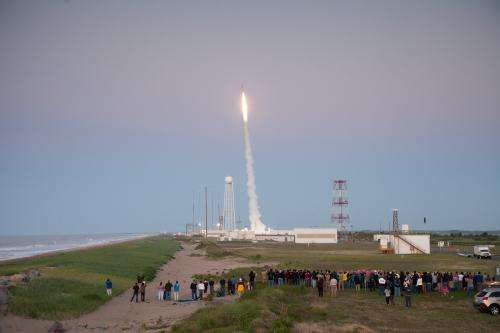NASA rocket launch successful, next launch June 24 from Wallops

Following the successful launch today, June 20, of a NASA Terrier-Improved Orion sounding rocket, launch teams are now preparing for a two-rocket salvo June 24 from the Wallops Flight Facility, Va.
The launch at 5:30 a.m. today carried experiments built by university instructors and students from across the country through the RockOn and RockSat-C programs conducted with the Colorado and Virginia Space Grant Consortia.
The programs are designed to provide participants an introduction to building small experiments that can be launched on sounding rockets. More than 100 students and instructors were at Wallops participating in the programs.
The experiments were carried to an altitude of 73 miles before descending by parachute and landing in the Atlantic Ocean. The payload was recovered, and the students will receive their experiments later today to begin analyzing the data collected.
Wallops' next launch is scheduled for June 24. Two rockets will launch 15-seconds apart in support of the Daytime Dynamo experiment, which is a joint project between NASA and the Japan Aerospace Exploration Agency, or JAXA.
The project is designed to study a global electrical current called the dynamo, which sweeps through the ionosphere. The ionosphere stretches from about 30 to 600 miles above Earth and plays a crucial role in our day-to-day lives. For example, radio waves bounce off it as they travel from sender to receiver, and communications signals from satellites travel through it as well. A disruption in the ionosphere can disrupt these signals.
The first rocket scheduled for launch is a single-stage Black Brant V, which will collect data on the neutral and charged particles it travels through. The second rocket is a two-stage Terrier-Improved Orion. It will shoot out a long trail of lithium gas to track how the upper atmospheric wind varies with altitude. These winds are believed to be the drivers of the dynamo currents.
Since the launch is during the day, the lithium trails will not be highly visible to the naked eye.
Based on the approved range schedule, the rockets are set for launch between 9:30 and 11:30 a.m. June 24. The backup launch days are June 25 and from June 28 to July 8.
The rockets will be visible to residents in the Wallops region. The NASA Visitor Center will open at 8 a.m. on launch day for viewing the launches.
Provided by NASA's Goddard Space Flight Center


















